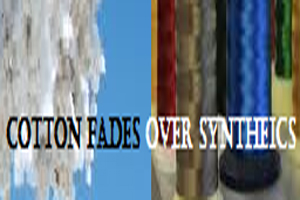
Natural fiber cotton, fades over synthetics in US apparel industry
YarnsandFibers News Bureau 2014-03-16 10:00:00 – USALove of natural fibers, cotton fade away as lower priced synthetics attract the designers and consumers in US apparel industry. Cotton is no longer king of the apparel as the American wardrobes has been taken over by synthetic clothing.
US imports of synthetic clothing may overtake cotton garments for the first time in decades this year, while US mills increasingly use artificial blends amid an unexpected revival of the threadbare domestic textile industry.
Cotton prices spiked to historic highs three years ago alongwith change in technology, marketing, and consumer sentiment as forced the market to shift around synthetics. Polyester yarn has evolved immensely.
Last October Georgia’s governor announced that the No. 1 US miller, Parkdale Inc, which alone accounts for more than half of US cotton demand, would spend $85 million plans to convert a plant which for years made 100 percent cotton yarn for iconic Hanes Brand T-shirts to blend synthetic fiber.
Parkdale, based in Gastonia, North Carolina, has seen a huge uptick in polyester demand across its product lines in recent years that is unlikely to be reversed.
The switch to man-made fibers has accelerated in recent years as demand for cotton stagnates even though prices have fallen back to less than $1 as synthetics in China, the world’s top textile market, are still cheaper.
According to the National Cotton Council of America, in China, polyester prices traded at about 68 cents a lb, less than half the price of cotton, during the week ending March 6.
For the first time in 20 years, imports of clothing made chiefly of synthetic fibers, such as polyester and viscose, almost rivaled those of cotton clothing in 2013, according to data from the US International Trade Administration.
US buyers imported 12.29 billion square-meter equivalents worth of cotton apparel last year compared to 12.04 billion sme of apparel made of man-made fibers. The trend shows that there is a rise in synthetic imports by more than 20 percent over the past three years; cotton imports have plunge by 14 percent.
U.K.-based textile consultancy and research firm PCI Fibres has forecast fiber mill cotton consumption in the United States and Canada to drop to 776,000 tonnes by 2020 from 802,000 tonnes in 2015 and above 2 million tonnes in 2000. Synthetics have several advantages over their natural rival: without the threat of weather or disease, quality and supplies are more consistent, prices are more stable and technology has cut costs and increased efficiency.
Cotton Inc. a marketing group to promote cotton over synthetic fibers has boosted its efforts to capture younger buyers’ attention.
Market Intelligence
Ask for free sample Report

experience
Customer Base
dedicated team
Countries Served Worldwide









